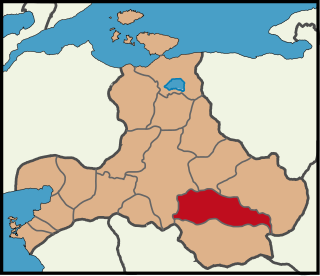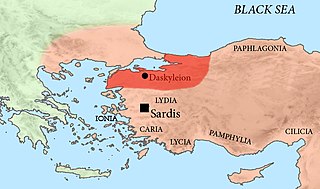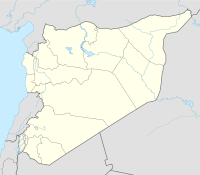
Bigadiç is a municipality and district of Balıkesir Province, Turkey. Its area is 1,108 km2, and its population is 48,917 (2022). As former Ancient bishopric of Achyraus, it remains a Latin Catholic titular see.

İpsala is a town in Edirne Province in northwestern Turkey. It is the seat of İpsala District. Its population is 8,546 (2022). It is the location of one of the main border checkpoints between Greece and Turkey. The Greek town opposite İpsala is Kipoi.
Berissa, also spelled Berisa, Verisa, or Verissa, was a city in the late Roman province of Pontus Polemoniacus, in Asia Minor, which Kiepert and W. M. Ramsay have identified with the modern village of Baulus, 25 kilometres south-west of Tokat.

Cyrrhus is a city in ancient Syria founded by Seleucus Nicator, one of Alexander the Great's generals. Other names for the city include Coricium, Corice, Hagioupolis, Nebi Huri, and Khoros. A false etymology of the sixth century connects it to Cyrus, king of Persia due to the resemblance of the names. The former Roman/Byzantine (arch)bishopric is now a double Catholic titular see.
Basilinopolis or Basilinoupolis was a town in Bithynia Prima, which obtained the rank of a city under, or perhaps shortly before, Roman Emperor Julian the Apostate, whose mother was Basilina.
Cotenna or Kotenna was a city in the Roman province of Pamphylia I in Asia Minor. It corresponds to modern Gödene (Menteşbey), near Antalya/Turkey.

Citharizum was a town and fortress on the south arm of the Euphrates in the Roman province of Armenia III. It was a place of great strength which was built by the emperor Justinian and was the residence of one of the five prefects whom that emperor placed over Roman Armenia with the title of “Dux.”
Cestrus was a city in the Roman province of Isauria, in Asia Minor. Its placing within Isauria is given by Hierocles, Georgius Cyprius, and Parthey's. While recognizing what the ancient sources said, Le Quien supposed that the town, whose site has not been identified, took its name from the River Cestros and was thus in Pamphylia. Following Lequien's hypothesis, the 19th-century annual publication Gerarchia cattolica identified the town with "Ak-Sou", which Sophrone Pétridès called an odd mistake, since this is the name of the River Cestros, not of a city.
Cidyessus or Kidyessos was a city of some importance, west of Ammonia in west-central ancient Phrygia, in the territory of the Setchanli Ova, or Mouse Plain; this large and fertile valley projects far into Phrygia Salutaris, but the city was in Phrygia Pacatiana.
Circesium, known in Arabic as al-Qarqisiya, was a Roman fortress city near the junction of the Euphrates and Khabur rivers, located at the empire's eastern frontier with the Sasanian Empire. Procopius calls it the "farthest fortress" of the Romans. It was later conquered by the Muslim Arabs in the 7th century and was often a point of contention between various Muslim states due to its strategic location between Syria and Iraq. The modern town of al-Busayra corresponds with the site of Circesium.

Dascylium, Dascyleium, or Daskyleion, also known as Dascylus, was a town in Anatolia some 30 kilometres (19 mi) inland from the coast of the Propontis, at modern Ergili, Turkey. Its site was rediscovered in 1952 and has since been excavated.
Dalisandus or Dalisandos was a city of ancient Cappadocia and later of Isauria, near the river Cydnus. It is considered to have been near Sınabiç, 6 km north of Claudiopolis, Turkey.
Dülük is a neighbourhood in the municipality and district of Şehitkamil, Gaziantep Province, Turkey. Its population is 2,826 (2022). It is about 10 kilometres (6.2 mi) from Gaziantep city center. Its ancient name was Doliche.
Choma was a place in the interior of ancient Lycia, according to Pliny on a river Aedesa. Ptolemy places Choma as one of the four cities of the Milyas, and places it near Candyba. The town can be identified with a site near today's village of Hacımusalar in the district of Elmalı.
Comba or Komba was a city in ancient Lycia. Comba lay inland, near Mount Cragus, and the cities Octapolis and Symbra. Its site is located near Gömbe in Asiatic Turkey.
Dalisandus or Dalisandos was an ancient city and bishopric in eastern Pamphylia, in Asia Minor and remains a Latin titular see.

Sura (Suriya), was an ancient city on the Euphrates River in northern Syria, today on a site 25 km west of Raqqa and 35 km north of Resafa. In the Roman Empire, Sura was a fortress city in the Roman province of Syria, and later on, in the Euphratensis.
Claneus or Klaneos or Klaneous was an ancient city and bishopric in Asia Minor. Its site is tentatively located near Turgut, Yunak, Turkey. Claneus was in the Roman province of either Phrygia Salutaris or Galatia Secunda.
Sergius I of Cyrrhus was a bishop of Cyrrhus, a Roman city in what is today Syria. He lived at a time when Cyrrhus was the center of a number of theological controversies, that birthed the Nestorian and Jacobite churches.
Isidorus of Cyrrhus was a bishop of Cyrrhus, a Roman city in what is today Syria. Cyrrhus was at the time a diocese about forty miles square and embracing 800 parishes.







